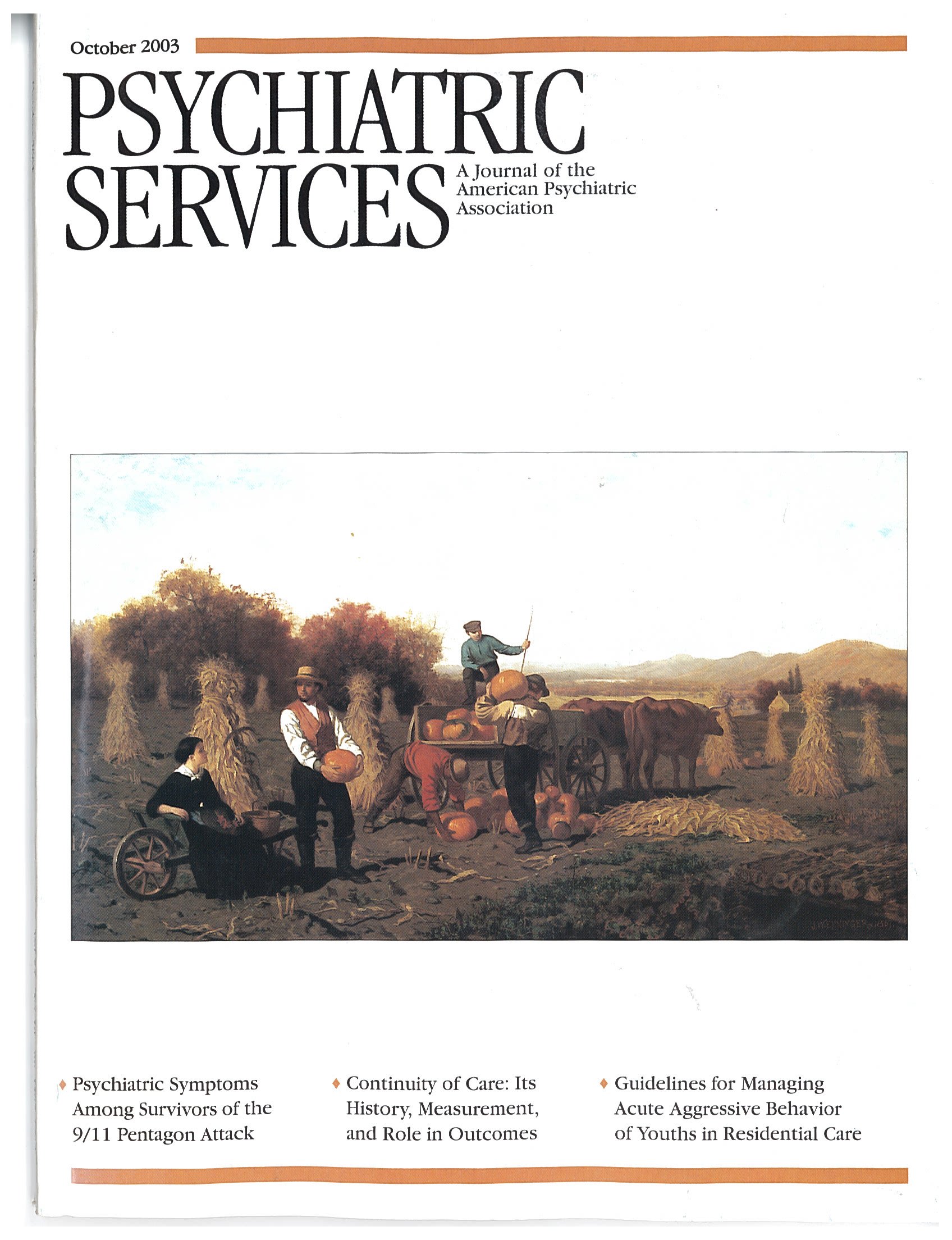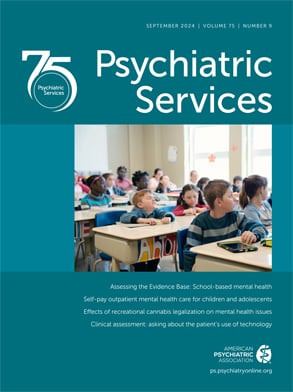The terrorist attack on the Pentagon on September 11, 2001, resulted in the death of 125 military and civilian Pentagon employees and 64 passengers and crew aboard the hijacked aircraft. The explosion, fire, and partial building collapse caused massive damage and placed many people at risk of injury and death.
In the week after the terrorist attacks, an estimated 44 percent of adults in the United States had at least one substantial symptom of stress, and 90 percent had at least low levels of stress symptoms (
1). In New York City, an estimated 7.5 to 11.2 percent of the population had posttraumatic stress disorder (PTSD) after one or two months, and 9.7 percent had depression (
2,
3). Similarly, approximately 35 percent of those who were directly exposed to the Oklahoma City terrorist bombing developed PTSD by six months (
4). Among residents of Manhattan, an estimated 25 percent had increased their use of alcohol five to eight weeks after the September 11 attacks (
5).
A chronic sense of decreased safety may lead to altered health behaviors, long-term effects on emotional and physical health, and increased use of health care services (
6,
7). Three to five days after the September 11 terrorist attacks, an estimated 47 percent of the U.S. population were worried about their own safety or the safety of loved ones (
1). At two months, 60 percent reported fear of a terrorist attack, and at six months nearly 40 percent reported such fear (
8).
To better understand the effects of terrorist attacks, we examined PTSD, alcohol use, and changes in perceptions of safety among survivors of the Pentagon attack seven months after the event.
Methods
Study participants
Seven months after the terrorist attack on the Pentagon and after review and approval by our institutional review board, we contacted approximately 680 military and civilian staff in one of the Pentagon commands by electronic questionnaire that provided discussion of risks and benefits and provided a contact point for any questions or concerns. To preserve confidentiality, the institutional review board waived the requirement for written informed consent. We received 77 anonymous responses via an Internet server. Of the individuals who responded, 59 (77 percent) were men, and 60 (77 percent) were active-duty military personnel. The mean±SD age of the respondents was 36.9±9.5 years. The group was predominantly Caucasian (62 respondents, or 81 percent). All participants had at least a high school education, and 49 (64 percent) had a college degree.
Assessments
PTSD, alcohol use, and perceived safety. PTSD was assessed with use of the Impact of Events Scale-Revised (IES-R) (
9). We used a binary indicator of presence of PTSD based on endorsement of symptoms according to
DSM-IV criteria: one intrusion symptom, three avoidance symptoms, and two hyperarousal symptoms (
6,
10). Alcohol use since September 11 was assessed with one question asking about "using alcohol more than you meant to" since the attack. Current perceived safety was assessed with use of a total score from three questions: safety at work, safety at home, and safety throughout the day in usual activities and travel. Each item was scored on a 5-point Likert scale ranging from 1, not at all, through 5, extremely, with a range for overall safety of 3, low safety, to 15, high safety (Cronbach's alpha=.82).
Trauma, peritraumatic dissociation, and initial emotional response. Past trauma was assessed with use of items asking about life-threatening military experiences and any past experience that caused fear of death or injury. Exposure during the attack was assessed with use of four subscales in which each individual item was answered "yes" or "no": sensory exposure (seeing the aircraft, hearing the aircraft before the impact, hearing the impact, feeling the impact, seeing the fireball and flying debris, and smelling smoke or jet fuel); difficulty escaping and being trapped; exposures to death (witnessing someone being killed, handling dead bodies, and serving as a lay counselor to families of the dead); and threat to life during the attack (fear of death or serious injury). For each scale the total number of endorsed items was summed and converted to a 10-point scale. The sum of the four subscales constituted the exposure scale.
Symptoms of dissociation during or shortly after the event (peritraumatic dissociation) were measured with use of the Peritraumatic Dissociative Experiences Questionnaire (PDEQ) (
11). Initial emotional response to the attack was assessed by using the sum of the responses to five items: feeling frightened, feeling helpless, feeling anxious, feeling horrified, and feeling hopeless, scored on a 5-point Likert scale from 1, not at all, to 5, extremely (Cronbach's alpha=.86). Possible total scores range from 5 to 25, with higher scores indicating more severe emotional responses.
Statistical analyses
Associations between categorical variables were evaluated by binary logistic regression. The estimate of the odds ratio and its 95 percent confidence interval (CI) are reported. The Mann-Whitney test was used to evaluate differences in means for continuous variables. Statistical analysis was performed with use of SPSS for Windows, version 11.
Results
Past trauma and exposure to the attack
Forty-seven (62 percent) of the survivors had previously had a life-threatening experience. Twenty-three respondents (32 percent) were in the Pentagon building at the time of the attack, and 25 (34 percent) were a short distance from the Pentagon. Fifty-four respondents (70 percent) saw, heard, felt, or smelled the aircraft, the explosion, or the resultant fire, and ten respondents (13 percent) reported that they had difficulty with evacuation. Ten persons (13 percent) saw someone die, 25 (33 percent) feared death, and 27 (35 percent) knew at least one person who was killed in the attack. None of the respondents was physically injured as a result of the attack.
Posttraumatic stress disorder
Eleven respondents (14 percent) met criteria for probable PTSD at seven months. Women were 5.4 times as likely as men to develop PTSD (Wald χ2=6.07, df=1, p=.014, CI=1.41 to 20.65). Peritraumatic dissociation was higher among persons with PTSD than those without PTSD (18.18± 7.97 compared with 4.81±6.25, z=−4.51, p<.001). Initial emotional response was greater among persons with PTSD than among those without PTSD (10.36±6.74 compared with 5.87±4.74, z=−2.11, p=.035). Persons with PTSD reported lower perceived safety than did those without PTSD (9±1.76 compared with 12.03±2.62, z=−3.42, p=.001). No relationship was found between PTSD and age, previous trauma, or the degree of exposure during the attack.
Alcohol use
Ten respondents (13 percent) reported that they had used more alcohol than they intended since September 11. Women were 6.75 times as likely as men to report increased alcohol use (Wald χ2=7.03, df=1, p=.008, CI=1.65 to 27.68). Persons with PTSD were 5.62 times as likely as those without PTSD to report increased alcohol use (Wald χ2=5.17, df=1, p=.023, CI=1.27 to 24.88). Peritraumatic dissociation was higher among persons with increased alcohol use than among those with no increase in use (11.80±9.77 compared with 6±7.52, z=−2.10, p=.036). Respondents with increased alcohol use reported lower perceived safety (9.9±2.02 compared with 11.89±2.73, z=−2.35, p=.019.). No relationship was found between increased alcohol use and age, previous trauma, degree of exposure during the attack, or initial emotional response.
Safety at work, home, and in daily activities
Persons with high peritraumatic dissociation (at least four symptoms) (N=41) reported lower perceived safety than those with low peritraumatic dissociation (fewer than four symptoms) (N=34) (11.03±2.59 compared with 12.32±2.78, z=−2.14, p=.03). Those with high initial emotional response (score of at least 7) (N=32) reported lower perceived safety than those with low initial emotional response (score of less than 7) (N=43) (10.71±2.98 compared with 12.28±2.34, z=−2.22, p=.026). Women reported lower perceived safety than men (10.17±2.23 compared with 12.09±2.72, z=−2.89, p=.004). No relationship was found between perceived safety and age, previous trauma, or degree of exposure during the attack.
Discussion and conclusions
No previous studies have assessed responses of Pentagon survivors to the terrorist attacks of September 11. At the time of this study, individuals who were assigned to the Pentagon were deeply involved in the war in Afghanistan, which may have accounted for the low response rate (11 percent). The generalizability of these results to the prevalence of exposure and psychiatric responses in the sampled population is limited, because selection biases are unknown. Despite these limitations, we noted wide variance in previous life experiences, exposure at the time of the attack, initial emotional responses, and subsequent symptoms, behaviors, and attitudes. The composition of the sample reflects the composition of the studied command and generally reflects that of the Pentagon, although civilian employees were somewhat underrepresented in our sample (27 percent compared with approximately 40 percent in the Pentagon).
The study sample constituted a highly exposed group; 70 percent of the respondents reported that they saw, heard, felt, or smelled the aircraft, the explosion, or the fire. The rate of probable PTSD at seven months (14 percent) was lower than the rate of probable PTSD among persons who were directly exposed in Oklahoma City (35 percent) (
4) but substantially greater than the rates of probable PTSD in the Washington, D.C., metropolitan area (2.7 percent) (
3). The association between early dissociative symptoms and subsequent PTSD and the greater risk among women of developing the disorder is consistent with numerous previous studies (
12,
13,
14).
We found higher rates of alcohol use among persons with PTSD at seven months. This finding is similar to findings of increased alcohol use and its association with PTSD in Manhattan five to eight weeks after the September 11 attacks (
5). Increased rates of postdisaster substance use disorders were not found after the Oklahoma City bombing (
4), which suggests that increased use can occur as a coping behavior without the presence of an alcohol use disorder. Increased alcohol use was also associated with changes in perceived safety. Increases in substance use appear to be important targets for public health and primary care interventions after terrorist attacks and traumatic events.
The association of perceived safety with gender, the presence of PTSD, and increased alcohol use warrants further study. Concerns about safety were high throughout the nation immediately after the September 11 attacks (
1). Our results suggest that an altered perception of safety persisted, at least among persons who were most directly exposed, even at seven months after the terrorist event. Perceptions of vulnerability in the context of other terrorist attacks were associated with increased use of health care services (
15,
16,
17,
18). Lowered perceptions of safety may have implications for social and work-related behaviors that can affect long-term morale and productivity.
This study may represent a "best case" scenario of the psychological consequences of a terrorist attack in the United States. The sample was taken from a group of highly educated, employed, socially supported individuals, many of whom had warfare skills and had survived previous traumatic events without known negative sequelae. Decreased perceptions of safety on an ongoing basis may result in psychological, behavioral, and physical health problems and constitute an area for further research in this and other populations exposed to terrorist attacks.

